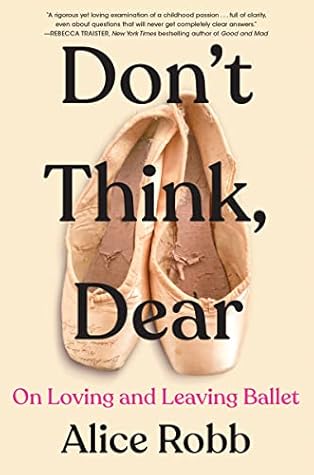More on this book
Community
Kindle Notes & Highlights
by
Alice Robb
Read between
October 23 - November 3, 2024
Even the pain of ballet could enhance our awareness of the body. Pain disrupts the cycle of bodily neglect, intruding on our consciousness and forcing us to remember that we have a physical form.
Perel put it, “movement that is not about performance, but about experience.”
Sports and exercise can blunt the dark forces alienating women from themselves: striving for and achieving athletic goals can help women appreciate their bodies as more than just aesthetic objects.
As recently as the 1960s and ’70s, according to Danielle Friedman’s 2022 book Let’s Get Physical: How Women Discovered Exercise and Reshaped the World, women were systematically excluded from most forms of exercise. Doctors believed it was dangerous for women to exert themselves, especially when they were on their periods; rumor held that vigorous exercise could even cause a woman’s uterus to fall out. Sweating in public was considered unladylike, as were visible muscles.
Ballet dancers and ex-dancers were the mothers of the women’s fitness movement.
I used to feel this sense of embodiment all the time, even when I wasn’t dancing. I would lie in bed or sit in class, my legs folded into a hard plastic chair, and I would sense my muscles brimming with potential energy; I felt powerful, knowing what my body could do. I felt like my body was different.
Through years of practicing turns, they had trained their brains to suppress the sensation of dizziness.
Two sisters born without the receptor that carries touch into conscious awareness grew up to need wheelchairs; they explained in a Vox profile that, due to their poor proprioception, they were liable to fall down if the lights went out, or to grow disoriented if a strand of hair fell in front of their face.)
Dancers have a heightened sense, too, of the invisible inner workings of the body. “Interoception” is the sense of our own internal states—our awareness of the physical signals that travel from body to brain, telling us when it’s time to eat or drink or empty our bladder.
Ballet—which originated in the royal courts of seventeenth-century France—has, paradoxically, thrived under communist regimes.
Ballet, Alicia believed, wasn’t just for the elites to admire, or for gifted pupils to study; it was for the masses to enjoy, both as spectators and as participants.
Nondancers, too, have remarked that dancers resemble a “different species.” The reason, I think, that you can spot a dancer from across a room is not her hairstyle or her makeup or her thinness; it’s her ineffable presence in her body, her superhuman awareness of space and herself. It’s her presence in every movement, whether a grand jeté or a tilt of the head or nothing at all; her stillness, too, is deliberate, is pregnant with potential movement. Even a dancer’s headshot—a close-up of just her face, perhaps her neck—conveys the possibility of motion: she seems poised to leap out of the
...more
“Though you move on you don’t ever completely get over it. That loss is part of your life and who you are forever.”
Some of my old classmates rigorously avoid ballet—watching it, doing it, talking about it. Some of them didn’t want to participate in this book. They find it too painful: a reminder of all they have lost.
She was in her late thirties then, with an enviable career—she had written several books and been an art director for the New York Times; her textile designs had appeared on high-fashion runways—and yet she still defined herself by her “brief, intense years as an athlete.”
The details don’t matter. What matters is this: the euphoria, the relief, as I discover that it’s not too late, after all. The exquisite pain of waking up, of remembering that it was just a dream. That I am not a dancer after all.
My teacher was right. Ballet is not fun. It’s meditation; it’s a physical prayer. It’s striving for perfection and then giving in to the moment.
I catch a glimpse of myself in the mirror, and I cringe the way I do when I hear myself speaking French: I know how that verb is supposed to sound, how this step is supposed to look, and I’m momentarily surprised to see that I no longer have the ability to do it. I feel self-conscious when the teacher corrects me—Why are you wasting your time? I want to ask. And then I feel defensive: I know I’m doing it wrong.


